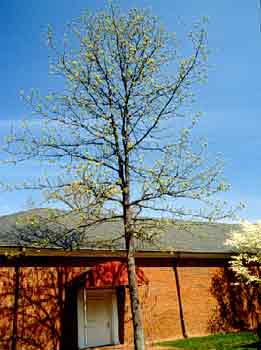 Shellbark Hickory - Carya laciniosa
Shellbark Hickory - Carya laciniosa
Walnut Family (Juglandaceae)
Introduction: Shellbark hickory is similar to the pignut and shagbark hickories. It was once abundant in American bottom lands but is now nearly gone from its native habitat. Its striking bark and large winter buds add to the ornamental value of the tall, slender tree. The bud scales fold back, petal-like, as new foliage emerges. Characteristic bright orange twigs, its open habit and its bark give it winter interest.
Culture: Large, slow-growing shellbark hickory thrives in full sun or partial shade in deep, fertile, moist soils. It grows well in wet bottom lands and may withstand its roots being periodically submerged. Plant it in a park-like area where large size, leaf litter, fruit and twig drop will not be a problem. Its savory nuts attract squirrels and other animals that may be unwanted in a residential area. Although this tree is self-fertile, cross-fertilization produces an increased number of better-quality nuts. The hickory bark beetle is sometimes a significant pest on this tree, as are borers and twig girdler. Seed production can be reduced by pecan weevil and hickory shuckworm. Hickory isresistant to Verticillium wilt.

Botanical Information
- Native habitat: New York west to Iowa, south to Oklahoma and Tennessee in flood plains and bottom lands.
- Growth habit: This large tree is high-branching with a straight, slender trunk and a narrow crown. Lower branches droop, upper ascend.
- Tree size: A very slow-growing tree, this species attains a height of 60 to 80 feet.
- Flower and fruit: Male flowers are 5- to 8-inch-long catkins. Female flowers are in 2- to 5-flowered spikes. Fruit is an edible nut in a thick, chestnut-brown to orange-brown husk.
 Leaf: Generally this 10- to 24-inch- long leaf has seven downy leaflets. Fall color is yellow-brown and leafstalks persist on the branches through the winter.
Leaf: Generally this 10- to 24-inch- long leaf has seven downy leaflets. Fall color is yellow-brown and leafstalks persist on the branches through the winter.- Hardiness: Winter hardy to USDA Zone 5.
Additional information:
The genus name, Carya, is from the Greek name for the walnut tree (karya); its species name, laciniosa, means shredded or cleft into narrow divisions, referring to the loosening plates of bark. Although only a few hickory species exist outside of eastern North America (in eastern Asia), fossils indicate that hickories were once found in central Europe, China, the former Soviet Union, the western and southwestern U.S. and Alaska. Shellbark hickory has the largest nut of the hickories. Native Americans stored massive quantities of these hickory nuts, as "hickory milk" was a nutritious staple of most of their cooking. The wood of shellbark hickory is heavy and tough, yet flexible and shock-resistant. Because of these qualities, it is used in sporting goods, such as skis, and for tool handles. It is also used for furniture, veneer, fuel and charcoal. American pioneers were also aware of hickory's excellence as a source of fuel and used the wood to heat their drafty cabins. Shellbark hickory, abundant at settlements on bottom lands, was overused. Native populations were nearly eliminated and today are still rare.Wild hickories have deep tap roots that make them difficult to transplant. All hickories leaf out late in the spring. Shellbark hickory was introduced into cultivation in North America in 1800.The 139-foot national champion is in Greenup, Ky.
The genus name, Carya, is from the Greek name for the walnut tree (karya); its species name, laciniosa, means shredded or cleft into narrow divisions, referring to the loosening plates of bark. Although only a few hickory species exist outside of eastern North America (in eastern Asia), fossils indicate that hickories were once found in central Europe, China, the former Soviet Union, the western and southwestern U.S. and Alaska. Shellbark hickory has the largest nut of the hickories. Native Americans stored massive quantities of these hickory nuts, as "hickory milk" was a nutritious staple of most of their cooking. The wood of shellbark hickory is heavy and tough, yet flexible and shock-resistant. Because of these qualities, it is used in sporting goods, such as skis, and for tool handles. It is also used for furniture, veneer, fuel and charcoal. American pioneers were also aware of hickory's excellence as a source of fuel and used the wood to heat their drafty cabins. Shellbark hickory, abundant at settlements on bottom lands, was overused. Native populations were nearly eliminated and today are still rare.Wild hickories have deep tap roots that make them difficult to transplant. All hickories leaf out late in the spring. Shellbark hickory was introduced into cultivation in North America in 1800.The 139-foot national champion is in Greenup, Ky.




